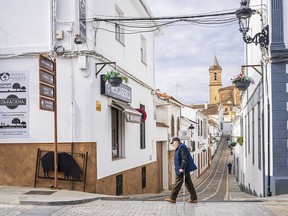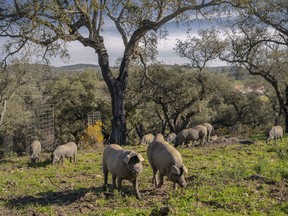
Reviews and recommendations are unbiased and products are independently selected. Postmedia may earn an affiliate commission from purchases made through links on this page.
Article content
ARACENA, Spain – “How do you like ham?” asked Manolo Romero de la Ossa, owner of Casas, a popular restaurant here in Andalusia.
Advertisement 2
Article content
All week in the town of Jabugo, my wife and I had been eating jamón ibérico de bellota, the sweet, nutty, salty, creamy product of free-range, black-hoofed pigs that eat a special diet.
Article content
“That’s great,” I said. Then I mentioned how much ham we had been eating.
“It does not matter?” Romero de la Ossa said, dismissing me with a wave of his hand. “You are in the ham capital of Spain, even of the world, and when it is so good you can’t stop. You eat it for breakfast, lunch and dinner.”
He was right. Confusing cured Spanish ham (pronounced “hahm-ohn”) with the cut and packaged ham found at your local supermarket would be like comparing a fast food burger with a wagyu steak, or Pabst Blue Ribbon with a Czech bottle of Pilsner Urquell. . . Not even Italian prosciutto is in the same league. Acorn-fed Iberian Ham is another beast. For about three months a year, Iberian pigs graze on acorns (or acorns in Spanish), which gives the ham a rich flavor that some Spaniards have compared to a drug.
Advertisement 3
Article content

Jabugo is synonymous with the highest quality ham in Spain and, according to some, in the world. I came here because my Spanish friends whispered in an irreverent tone when someone said the phrase “jamón de Jabugo.” I felt like I was being told some culinary secret: the best cured ham on the planet comes from a town of about 2,200 people nestled in the mountains of southern Spain.
Does pig tourism exist? There is in Jabugo.
The city is so focused on ham that the main square is called Plaza del Jamón and there are a series of bronze sculptures of ham cutters. There are also museums dedicated to Spanish ham in Jabugo and Aracena.
Jabugo has a handful of ham producers. The most famous is Cinco Jotas. The company offers several services so that visitors can literally get their hands dirty and dazzle their palates. I signed up for the full experience, which includes a visit to the oak-filled pasture to hang out with the pigs, a tour of the 19th century ham curing cellars, a lesson on how to carve ham like a pro, and of course Of course, Of course, a tasting.
Article content
Advertisement 4
Article content
All of this gave me a much better idea of how much time and effort it takes to develop an unparalleled product and why it is so expensive. A leg of black label Iberian ham can cost up to $1,700. Acorns are rich in fatty acids and nutrients. You could say they are a porcine superfood.
Spain has a handful of major ham-producing regions, including Salamanca, Extremadura, the Los Pedroches Valley and Jabugo. But not all Iberian ham is the same.
In 2014, the Spanish government created a color-coded system to inform consumers about the percentage of Iberian ancestry in pigs. A white label, for example, means that the breed of pig is at least 50 percent Iberian; eats mainly forage (a random mixture of grains, hay and vegetables); and he is not free.
Advertisement 5
Article content
At the other extreme is the black label, which means that the pig is 100% Iberian (or pata negra), feeds on acorns from November to February and is free-range. There are also dozens of strict regulations regarding the weight, size and amount of free space pigs must have, among other factors. Only six percent of the Iberian ham produced in Spain receives the black label designation.
The Iberian pig has fewer offspring than other breeds, produces less meat and takes longer to mature. For these reasons, many ham producers in Spain cross them. Cinco Jotas only uses 100% Iberian pork, making it one of the few ham producing companies in Spain to earn the black label designation.
What makes Jabugo ham so special?
Advertisement 6
Article content
In the southwest of Spain, ham has been cured for a long time. Even the Romans recognized the area as especially beneficial for the task of curing pork.
In the year 77 AD. C., the Roman writer Pliny the Elder wrote about Iberian pigs: “There is no animal that provides greater variety to the palate of the sybarite; All the others have their own peculiar flavor, but pork meat has almost fifty different flavors.” On Christopher Columbus’s second voyage, in 1493, it was said that his ships were loaded with Iberian pigs as they crossed the Atlantic.

Until the end of the 19th century, ham production in Jabugo was small-scale, limited to small family slaughterhouses. Only when a ham-obsessed businessman, Rafael Sánchez Romero, recognized the growing demand for Jabugo’s high-quality ham, did the product begin to spread to cities like Seville and beyond. He founded Cinco Jotas in 1879.
Advertisement 7
Article content
In 1994, Jabugo ham obtained DOP status – Protected Designation of Origin (literally “Protected Designation of Origin”) – a certification from the European Union that guarantees that a certain product comes from a specific geographical area. The area in question extends beyond Jabugo to another 30 surrounding towns where the ham produced is officially “jamon de Jabugo”.

“One of the most important factors in shaping the flavor of Jabugo ham is the microclimate here,” said José Antonio Pavón, general director of DOP Jabugo, the organization that maintains Jabugo’s DOP status. “Here it rains 1,000 liters, much more than in any other ham-producing region in Spain.”
Additionally, something called the Foehn effect (a meteorological term for what happens when there is a warm, dry condition on one side of a mountain and a cold, wet condition on the other, resulting in an extreme change in temperature) is caused by the Wind from the Atlantic Ocean hitting the high mountains of Jabugo.
Advertisement 8
Article content
“The daytime temperature in summer can be 105 degrees, and then at night it can drop to 65 degrees,” said María Castro Bermúdez Coronel, communications director for Cinco Jotas. “This affects that flavor, compared to other ham-producing regions, as the warm climate creates a strong flavor in the meat.”
The pigs are slaughtered – or “sacrificed” as the Spanish prefer to say – when they are around 22 months old. Then, the hind legs (called “ham”) and the front legs (called “paleta” or shoulder) rest in salt for a few weeks (one day per kilogram).
They then spend time in the drying process, hanging in a temperature-controlled room before being moved to a windowless basement for a few years. The entire process can take up to five years before a leg of ham is ready to be cut and savored.
Advertisement 9
Article content
How to get Iberian ham
Look in your local supermarket (or virtually any supermarket in the United States) and you probably won’t find jamón ibérico de bellota.
It’s not particularly difficult to find serrano ham, the most commonly produced ham in Spain, which is good but lacks the “wow” factor compared to black label acorn-fed Iberian ham. If you want it you have to go to a specialized food store, buy it online or, like me, go to the source.

Antonio Cabrera, sales manager at Covap, a ham producer in the Los Pedroches Valley, near Córdoba, and grandson of the company’s co-founder, said: “Italian culinary culture is so ingrained in the United States, especially in the East coast, which Many people have a cultural attachment to prosciutto.”
Advertisement 10
Article content
The United States government approved the importation of Iberian ham only in 2005, and its appearance in the United States – particularly the black label variety – has been advancing at a Mediterranean pace. “We have to catch up,” he said.
If you’re in Spain and want to bring back some black label acorn-fed Iberian ham (or other pork products, Spanish or not), you might want to think twice: it’s illegal.
However, there are many ways to buy it online: you can go directly to the source at Cinco Jotas or visit Spanish gourmet websites for the US market, including La Tienda, Campo Grande or Despaña.
For a 3-ounce package of sliced black label acorn-fed Iberico ham, expect to pay around $40. If you want to splurge and get your own leg, prices vary depending on weight and whether it’s the front leg or the heavier back leg.
Article content
